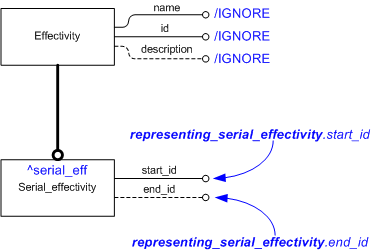| Template:— representing_serial_effectivity (rep_serial_eff) |
Date: 2008/03/05 18:28:10
Revision: 1.2
|
This section specifies the template representing_serial_effectivity.
NOTE
An explanation of a template and the associated instantiation path is
provided in the
Template overview
section.
The EXPRESS-G diagram in
Figure
1
shows the templates and EXPRESS entities that are required
to represent the template
"representing_serial_effectivity".
The text highlighted in blue shows the template parameters.
Figure 1 — An EXPRESS-G representation of the Information model for representing_serial_effectivity
The graphic for the template to be used in other EXPRESS-G diagrams
is shown in Figure
2
below.
Figure 2 — The graphical representation of the representing_serial_effectivity template
The following input parameters are defined for this template:
Identification of the first serialized item within a range of serialized items.
end_id (Type='STRING', Optional)
Identification of the last serialized item within the range of serialized items.
The following reference parameters are defined for this template:
Allow the
Serial_effectivity
entity instantiated in this path to be referenced when this template is used.
%^target = $representing_serial_effectivity.serial_eff%
The instantiation path shown below specifies the entities that are to be
instantiated by the template.
A description of templates and the syntax for the instantiation path is
provided in the
Templates Help/Information section.
The following entities are instantiated with attributes as specified:
The instance diagram in Figure
3
shows an example of the EXPRESS entities and templates that are instantiated by the template:
/representing_serial_effectivity(start_id='101', end_id='110')/
(an illustration of the consolidated representing_serial_effectivity template is shown in
Figure
4 below.)
Figure 3 — Entities instantiated by representing_serial_effectivity template
The instance diagram in
Figure
4
shows the graphic symbol for the template that is to be
used in other instance diagrams. The example template is:
/representing_serial_effectivity(start_id='101', end_id='110')/
Figure 4 — Instantiation of representing_serial_effectivity template
Characterizations
No common characterizations of the template
representing_serial_effectivity
have been identified. However, the ISO 10303-239 EXPRESS model
may enable other assignments to the entities instantiated by the template.




